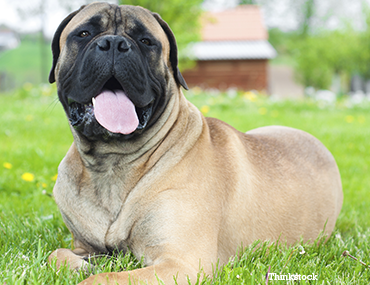Background:
The bullmastiff was bred in 19th century England to protect large game estates from poachers. Poachers were quite dangerous at the time as they were armed, and not afraid to maim or kill the game warden if they were caught.
The bullmastiff was bred to be 60% English mastiff and 40% bulldog. The idea was to create a dog who would be big, fast and aggressive enough to subdue a poacher, without killing him.
The bullmastiff was recognized by the English Kennel Club in 1924 as a pure-bred. They were recognized by the American Kennel Club in 1933, and the first breed standard was approved in 1935.
Sizing up:
- Weight: 100 to 130 lbs
- Height: 24 to 27 inches
- Coat: Short, low maintenance
- Color: Fawn, red, brindle
- Life Expectancy: 7-8 years
What’s the bullmastiff like?
The bullmastiff, in spite of his size, is sweet and loving around family members. He can be territorial though, and possibly aggressive if he ever feels that his family or property are in danger.
He’s intelligent and can be difficult to train because he’s an independent thinker and doesn’t like to perform repetitive activities. A bullmastiff will enjoy training, but only if you mix it up. Challenge him with obedience, agility, tracking and carting.
The bullmastiff is confident and will be great with strangers so long as he feels they’re welcome. He might not do so well with other dogs, especially dogs of the same sex. He’s not the best choice if you frequent dog parks.
The bullmastiff is low maintenance, and does not require much exercise or grooming. He can live happily in a big back yard or a small apartment. He doesn’t bark much as he was bred to be silent and stealthy.
Remember that he’s fearless and you might need to identify what he would perceive as a danger before he goes charging headlong into it.
Health:
As a larger dog, the bullmastiff has a shorter life span than smaller dogs would. He might be particularly susceptible to several conditions:
- Bloat
- Lymphoma
- Arthritis
- Progressive retinal atrophy
- Hip dysplasia
- Elbow dysplasia
- Entropion
Takeaway points:
- The bullmastiff is an excellent guard dog
- The bullmastiff can be aggressive
- The bullmastiff can be happy in a smaller sized dwelling
- The bullmastiff is low maintenance
If you have any questions or concerns, you should always visit or call your veterinarian – they are your best resource to ensure the health and well-being of your pets.
![]()

